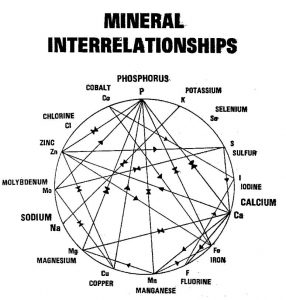Vitamins and Minerals
One critical nutrient that many times gets over looked, or given very little thought to, are vitamins and minerals. While they are often lumped together as a single nutrient we should view them individually and collectively. Each vitamin and mineral has it’s own unique function and then each one builds on the other to compliment or even antagonize another element. Sounds complex and it can be for sure.
Complex Interactions
Often in explaining about minerals I refer back to when I first began learning about them and their affect on animals. I remember our professor drawing a circle and on the outside of the circle were about five or six elements. They probably included the big ones like Ca-calcium, P-phosphorus and K-potassium. Then a few of those minor elements that we had discovered animals could have some other problems with like Se-selenium, Cu-copper and Co-cobalt. Now after he drew that circle with those elements on the outside, he began drawing connecting lines between known interactions of those elements. Meaning if we didn’t have enough of one the other could cause a problem we might not be expecting. Or it could be that the absence of an element prevents another function in the body as is the case of cobalt. Without sufficient cobalt in a ruminant animals body the synthesis of B12 is diminished. Without B12 the production of red blood cells is hampered. So you see those elements are very important individually, but they also play a role together for optimal health.
The drawn circle was a clear demonstration of how those minerals linked with each other in the animals body. One easy “link” to think about is calcium and phosphorus which make up bones. We know that within bone there is about two times as much calcium as there is phosphorus. And we know that if that ratio gets out of balance too far that structurally an animal can or will have problems! Thus that tells us if we are supplementing our animals with a mineral supplement we need to think about that interaction. Some of the other interactions were not so clear cut but when learning about biological processes they began to make sense. My purpose in this article is to get you thinking about mineral supplementation and that it is important. Important enough to ask more questions and read more about them but more importantly provide them to your livestock.
More Research = More Interactions
Now let’s fast forward a few years and look at that same circle, what was added and additional interactions. This drawing does not include the vitamins but those can be found and make it even a more complex drawing. This was taken from Langston University publication discussing goat nutrition.

Many other similar drawings can be found for other animal species. However, the common theme is the interactions or interrelationships between minerals. These interactions between minerals and vitamins allow an animal’s body to function properly and this is what makes correct mineral supplementation so important! Each specie might have differing requirements of each mineral but the interactions are going to remain. Thus a need for a complete supplement. One must take care when adding individual minerals or vitamin supplements as there could be consequences. Consult a nutritionist, veterinarian or an Extension Agent to discuss mineral needs before supplementing individual additives.
In Closing…
Earlier this year I wrote an article about mineral supplementation and it gives a more practical way of approaching the purchasing of mineral supplements. The link goes to the newsletter and you might find some other interesting articles as well!
There are many other aspects to consider when choosing the right supplementation for your livestock operation. This will at least get you started in the right direction and maybe you will want to ask more questions. The picture below is of young 2 to 3 month old calves that frequent the mineral feeder. One decided he needed to get in to look around a bit! But this picture shows that even young animals can be trained/taught to engage in mineral supplementation. Mineral supplements should be out year round even though they will consume more when their forage is more lacking nutritionally, typically now through the fall. If you need help or have questions don’t hesitate to contact us!

 0
0
